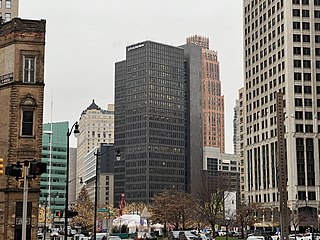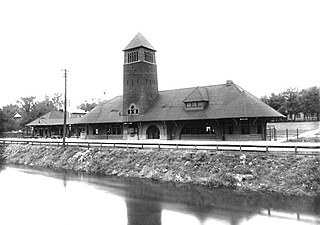
Corktown is a neighborhood located in Detroit, Michigan. It is the oldest extant neighborhood in the city. The current boundaries of the district include I-75 to the north, the Lodge Freeway to the east, Bagley and Porter streets to the south, and Rosa Parks Boulevard to the west. The neighborhood was listed on the National Register of Historic Places in 1978.

The Brass Era is an American term for the early period of automotive manufacturing, named for the prominent brass fittings used during this time for such features as lights and radiators. It is generally considered to encompass 1896 through 1915, a time when cars were often referred to as horseless carriages.

Fisher Body was an automobile coachbuilder founded by the Fisher brothers in 1908 in Detroit, Michigan.

Woodbridge is a historic neighborhood of primarily Victorian homes located in Detroit, Michigan. The district was listed on the National Register of Historic Places in 1980, with later boundary increases in 1997 and 2008. In addition to its historic value, Woodbridge is also notable for being an intact neighborhood of turn-of-the-century homes within walking or biking distance of Detroit's Downtown, Midtown, New Center, and Corktown neighborhoods.

Midtown Detroit is a commercial and residential district located along the east and west side of Woodward Avenue, north of Downtown Detroit, and south of the New Center area. The area includes several historic districts. In addition, it contains a residential area of some 14,550 people and covers 2.09 sq mi. The community area of neighborhoods is bounded by the Chrysler Freeway (I-75) on the east, the Lodge Freeway (M-10) on the west, the Edsel Ford Freeway (I-94) on the north, and the Fisher Freeway (I-75) on the south.

1001 Woodward is a 25-floor office building in Downtown Detroit, Michigan. It replaced the Majestic Building, a 14-story high rise on the same site. The building is located just south of the neighboring David Stott Building, at the corner of Woodward Avenue and Michigan Avenue overlooking Campus Martius Park. Constructed from 1963 to 1965, the building is designed in the International Style. It was listed on the National Register of Historic Places in 2013.

The Edwin S. George Building, built in 1908, is located at 4612 Woodward Avenue in Midtown Detroit, Michigan, at the corner of Woodward and Garfield. In 1914, the name was changed to the Garfield Building. It was listed on the National Register of Historic Places in 1993.

The Graybar Electric Company Building is located at 55 West Canfield Street in Midtown Detroit, Michigan. This warehouse building was rented to the Graybar Electric Company from 1926 into the 1940s. It was listed on the National Register of Historic Places in 1997.

The New Amsterdam Historic District is a historic district located in Detroit, Michigan. Buildings in this district are on or near three sequential east-west streets on the two blocks between Woodward Avenue and Second Avenue. It was listed on the National Register of Historic Places in 2001.

This is a list of the National Register of Historic Places listings in Detroit, Michigan.

The Park Avenue Historic District is a historic district located in Detroit, Michigan, along Park Avenue between Adams St. and I-75. The district includes the Women's City Club, the Detroit Building, and the Park Avenue House. The district was designated a Michigan State Historic Site in 1996 and listed on the National Register of Historic Places in 1997.

The Lower Woodward Avenue Historic District, also known as Merchant's Row, is a mixed-use retail, commercial, and residential district in downtown Detroit, Michigan, located between Campus Martius Park and Grand Circus Park Historic District at 1201 through 1449 Woodward Avenue and 1400 through 1456 Woodward Avenue. The district was listed on the National Register of Historic Places in 1999.

The Frederick Stearns Building is a manufacturing plant located at 6533 East Jefferson Avenue in Detroit, Michigan. The building was listed on the National Register of Historic Places in 1980 and designated a Michigan State Historic Site in 1981. It has been converted to condominiums.

The Dry Dock Complex consists of six interconnected buildings located at 1801–1803 Atwater Street in Detroit, Michigan, as well as the remains of a nearby dry dock at 1900 Atwater Street. The 1801-1803 Atwater complex is also known as the Globe Trading Company Building, and in 2015 was opened by the Michigan Department of Natural Resources as the Outdoor Adventure Center.

The Crescent Warehouse Historic District is a 10.5-acre (4.2 ha) historic district in Downtown Davenport, Iowa, United States. The district is a collection of multi-story brick structures that formerly housed warehouses and factories. Most of the buildings have been converted into loft apartments. The district was listed on the National Register of Historic Places in 2003.

The former Eighth Precinct Police Station is a building located at 4150 Grand River Avenue in the Woodbridge Historic District of Detroit, Michigan, United States. It is the second-oldest police building in Detroit, and was designated a Michigan State Historic Site in 1973 and listed on the National Register of Historic Places in 1974. The building now houses the Detroit Castle Lofts.

Rogers and MacFarlane was an architectural firm based in Detroit, Michigan, founded in 1885 by James S. Rogers and Walter MacFarlane. The firm produced commissions in Detroit and southern Michigan from 1885 until 1912.

The Russell Industrial Center is an industrial factory turned to commercial complex of studios and shops that is located at 1600 Clay Street in Detroit, Michigan. The Russell Industrial Center is a 2,200,000-square-foot (200,000 m2), seven building complex, designed by Albert Kahn for John William Murray in 1915. It contains studios and lofts and serves as a professional center for commercial and creative arts.

This is a list of the National Register of Historic Places listings in Downtown and Midtown Detroit, Michigan. It is intended to be a complete list of the properties and districts on the National Register of Historic Places in Downtown and Midtown neighborhoods in Detroit, Michigan, United States. Latitude and longitude coordinates are provided for many National Register properties and districts; these locations may be seen together in online maps.

The Checker Cab Building was built as a garage and office building located at 2128 Trumbull Avenue in Detroit, Michigan. It was listed on the National Register of Historic Places in 2019. The building has been rehabilitated into residences, and is now part of the Elton Park lofts.























